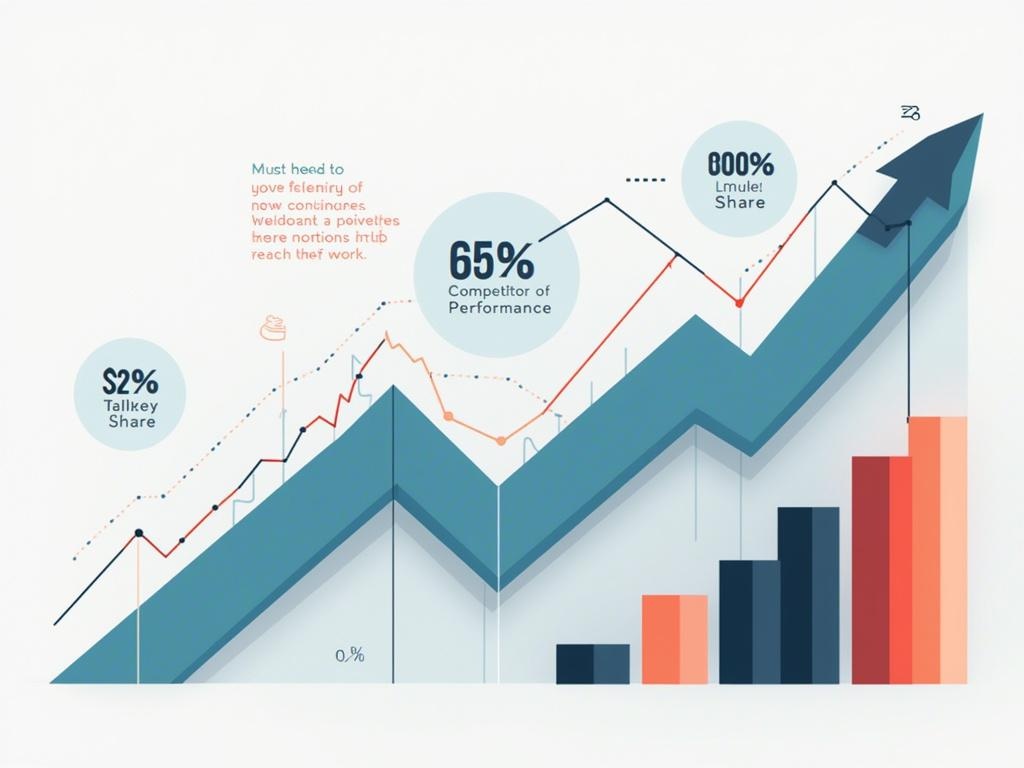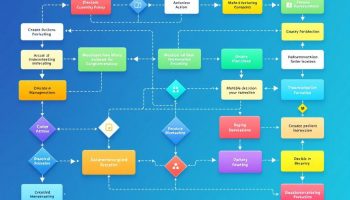
Comprehensive Competitor Benchmarking Guide
A comprehensive competitor benchmarking guide provides a systematic approach to comparing your company’s performance against industry rivals, enabling strategic insights that drive competitive advantage. By methodically analyzing key metrics like market share, revenue growth, and customer satisfaction, you can identify strengths, weaknesses, and improvement opportunities across critical business dimensions.
Key Takeaways
- Competitor benchmarking is a continuous process that requires regular monitoring and strategic evaluation of performance metrics.
- The approach helps organizations gain actionable insights by comparing performance against industry rivals.
- Multiple benchmarking types exist, including performance, process, strategic, and product benchmarking techniques.
- Effective benchmarking requires cross-functional collaboration and high-quality data sources.
- Technology and specialized tools can significantly enhance the benchmarking analysis and implementation process.
“Competitor benchmarking is not just a snapshot of where you stand; it’s a continuous journey that transforms insights into strategic advantage, empowering businesses to capitalize on strengths and address weaknesses. By leveraging comprehensive metrics and cross-functional collaboration, organizations can navigate their competitive landscape with agility and foresight.”
What is Competitive Benchmarking
Competitive benchmarking is a systematic process that compares your company’s performance against industry rivals to identify strengths, weaknesses, and improvement opportunities. This strategic practice helps you gain actionable insights that drive competitive advantage in your market. Your competitor benchmarking guide should focus on analyzing key metrics like market share, revenue growth, profitability, and customer satisfaction to understand where you stand in relation to competitors.
Unlike occasional competitive analysis, effective competitor benchmarking is a continuous process that requires regular monitoring and evaluation. You’ll need to establish clear metrics and maintain consistent tracking methods to spot emerging trends and respond promptly to market changes.
Types of Competitor Benchmarking
Your competitor benchmarking guide should include these four primary approaches:
- Performance Benchmarking: Compares quantitative metrics including market share, revenue, and operational efficiency to identify performance gaps.
- Process Benchmarking: Analyzes operational processes like manufacturing, supply chain, and distribution to improve efficiency.
- Strategic Benchmarking: Evaluates overall business strategy by examining business models, long-term approaches, and innovative practices.
- Product Benchmarking: Directly compares product features, pricing, quality, and customer satisfaction across competitors.
The benchmarking process follows a structured approach. First, define clear objectives aligned with your strategic planning goals. Next, identify both direct and indirect competitors for comprehensive analysis. Then collect quantitative and qualitative data through market research, industry reports, and customer feedback. Analyze performance gaps to pinpoint improvement areas and develop targeted action plans.
Implementation requires cross-functional collaboration and effective project collaboration to ensure success. Your competitor benchmarking guide should emphasize continuous monitoring to track progress and make necessary adjustments.
The benefits of systematic competitor benchmarking include identifying organizational strengths and weaknesses, supporting data-driven decisions, driving innovation, enhancing customer satisfaction, and motivating teams through clear industry-benchmarked goals. This process enables you to adapt proactively to market changes rather than reactively responding to competitive threats.
Common challenges include data availability, scope management, and resistance to change. To overcome these obstacles, align benchmarking initiatives with your overall business strategy, use high-quality data sources, involve cross-functional teams, and set realistic improvement goals that are regularly monitored through your competitor benchmarking guide.
Companies that engage in benchmarking achieve 20% higher productivity on average than those that do not.
forbes.com
Types of Competitive Benchmarking
Your competitor benchmarking guide should include various approaches to measuring performance against industry rivals. Effective benchmarking helps you identify competitive gaps and opportunities for strategic improvement.
Performance Benchmarking
Performance benchmarking focuses on quantitative metrics comparison between your organization and competitors. This competitor benchmarking guide approach examines key performance indicators that directly impact business success, including:
- Market share percentages across product lines and regions
- Revenue growth rates compared to industry averages
- Operational efficiency metrics such as cost-per-unit
- Profitability ratios including profit margins and ROI
- Customer acquisition costs versus industry standards
When performing competitive analysis through performance benchmarking, you’ll gain clear insights into where you stand numerically against rivals.
Process Benchmarking
Process Benchmarking analyzes operational workflows and methodologies. This type examines how competitors execute their business processes rather than just the end results. You’ll evaluate:
- Manufacturing efficiency and production techniques
- Supply chain optimization methods
- Customer service delivery systems
- Sales cycle management approaches
- Distribution channel effectiveness
Strategic Benchmarking
Strategic Benchmarking takes a broader view by examining overall business models and long-term approaches. This competitor benchmarking guide component helps you understand fundamental strategic differences by analyzing:
- Competitive positioning strategies
- Market entry and expansion approaches
- Innovation pipelines and R&D investments
- Partnership and alliance structures
- Long-term growth trajectories
Product Benchmarking
Product Benchmarking provides direct comparisons of specific offerings in the marketplace. This competitor website analysis approach examines:
- Feature-by-feature comparisons with competitive products
- Pricing strategies across market segments
- Quality assessments through independent testing
- Customer satisfaction ratings and reviews
- Value proposition differentiation
Functional Benchmarking
Functional Benchmarking looks at specific departmental practices across companies. This specialized form of competitor benchmarking guide analysis examines:
- Marketing campaign effectiveness and brand positioning
- HR practices including talent acquisition and retention
- Financial management approaches and investment strategies
- Technology infrastructure and digital transformation efforts
- Customer experience management systems
Implementing a comprehensive benchmarking program requires selecting the right types based on your specific business challenges and strategic planning objectives.

Competitive Benchmarking Process
The competitor benchmarking process forms the backbone of any successful competitive analysis strategy. You’ll need a structured approach to effectively measure your performance against industry rivals and gain actionable insights.
Begin by defining clear strategic objectives for your benchmarking efforts. Without specific goals, you risk collecting irrelevant data that won’t drive meaningful improvements. Your objectives should align with overall business strategies and focus on areas critical to your competitive advantage.
Next, identify the right competitors to benchmark against. This includes both direct competitors (offering similar products/services) and indirect competitors (serving the same customer needs differently). Performing thorough competitive analysis helps you select the most relevant benchmarking targets.
The data collection phase requires gathering comprehensive information across key metrics:
- Market share percentages and trends
- Revenue growth rates and profitability margins
- Operational efficiency indicators
- Customer satisfaction scores and loyalty metrics
- Product feature comparisons and pricing models
- Marketing effectiveness and brand perception
After collection, analyze performance gaps between your organization and competitors. Look for both strengths to leverage and weaknesses to address. This gap analysis reveals opportunities for improvement and competitive differentiation.
Based on findings, develop targeted action plans with specific initiatives, timelines, and responsibility assignments. These plans should prioritize improvements that deliver the greatest competitive impact.
Implementation requires cross-functional collaboration and effective project communication to ensure everyone understands the competitor benchmarking goals and their role in achievement. The process doesn’t end with implementation—continuous monitoring of results against benchmarks ensures ongoing competitive advantage.
Leveraging Technology in Competitor Benchmarking
Advanced technologies have transformed the competitor benchmarking process. You can now utilize specialized tools to automate data collection, enhance analysis accuracy, and generate actionable insights more efficiently.
Competitive intelligence platforms provide real-time competitor monitoring and automated alerts when significant changes occur. Data visualization tools help transform complex benchmarking data into intuitive dashboards that highlight critical performance gaps. Market research databases offer industry benchmarks that provide broader context for your competitive positioning.
When implementing a competitor benchmarking guide, remember that this process isn’t a one-time event but a continuous cycle of improvement. Regular reassessment ensures you maintain competitive advantages in rapidly evolving markets.
Expert Insight: To achieve meaningful insights from the competitive benchmarking process, begin by setting clear strategic objectives that align with your overall business goals. Next, carefully select relevant competitors—both direct and indirect—to ensure your data collection focuses on the right metrics, such as market share, customer satisfaction, and operational efficiency. Finally, leverage advanced technologies for data analysis and visualization, enabling you to continuously monitor performance gaps and adapt your strategies for sustained competitive advantage.
Benefits of Competitive Benchmarking
Effective competitor benchmarking gives you a significant advantage in today’s competitive marketplace. This systematic approach helps you understand where your business stands compared to industry rivals while providing a roadmap for improvement. Your competitor benchmarking guide should focus on measurable outcomes that directly impact your bottom line.
The most immediate benefit of implementing a comprehensive competitor benchmarking guide is gaining clear visibility into your organization’s strengths and weaknesses. This process helps you perform competitive analysis that reveals areas where you excel and identifies critical improvement opportunities. By understanding these gaps, you can allocate resources more effectively to address deficiencies.
Data-driven decision making becomes possible when you regularly benchmark against competitors. Your strategic choices no longer rely on assumptions but on concrete evidence about market positioning. This approach reduces risk and increases confidence in your strategic direction, especially when planning major initiatives.
Innovation thrives when you understand what competitors are doing well. Your competitor benchmarking guide will help identify industry best practices that can spark creative solutions within your own organization. This doesn’t mean simply copying competitors—it’s about learning from their successes and failures to develop your unique advantages.
The benefits of competitor benchmarking extend to several key areas:
- Improved customer satisfaction through understanding what competitors offer
- Enhanced operational efficiency by adopting industry-leading processes
- Clearer strategic focus based on market positioning analysis
- More effective resource allocation to high-impact initiatives
- Increased team motivation through measurable, competitive goals
Implementing for Maximum Impact
To maximize these benefits, your competitor benchmarking process should be integrated with your strategic planning efforts. This connection ensures benchmarking insights directly influence your business direction rather than becoming isolated data points.
| Benchmarking Type | Primary Benefits | Key Metrics |
|---|---|---|
| Performance | Quantifies competitive position | Market share, revenue growth, profitability |
| Process | Improves operational efficiency | Cycle times, cost structures, productivity |
| Strategic | Enhances long-term positioning | Business model effectiveness, innovation rate |
| Product | Drives product improvements | Features, pricing, customer satisfaction |
Remember that competitor benchmarking isn’t a one-time exercise. You’ll gain the most value by establishing it as an ongoing practice within your organization, regularly updating your competitor benchmarking guide as market conditions evolve.
Companies that conduct regular competitive benchmarking are 12 times more likely to achieve their strategic goals than those that do not.
hbr.org
Challenges and Best Practices
Even with a solid competitor benchmarking guide in place, you’ll likely encounter several obstacles when implementing your strategy. Data availability remains one of the most significant challenges – competitors rarely share their performance metrics willingly. Without reliable information, your benchmarking efforts may lead to flawed conclusions.
Managing scope creep presents another common hurdle. When undertaking competitor benchmarking, it’s tempting to analyze everything at once, which can dilute your focus and waste resources on non-critical areas.
Overcoming Implementation Barriers
To maximize your competitor benchmarking guide effectiveness, consider these best practices:
- Align benchmarking initiatives with your overall business objectives to ensure relevance and maximize ROI.
- Diversify data sources by combining industry reports, market research, and competitor website analysis tools for more comprehensive insights.
- Build cross-functional teams that bring diverse perspectives to the benchmarking process.
- Establish realistic improvement targets based on your current capabilities and resources.
- Implement continuous monitoring systems to track progress and adjust strategies as needed.
“The most successful organizations treat competitor benchmarking as an ongoing practice rather than a periodic exercise,” notes the Harvard Business Review in their study on competitive intelligence practices.
You’ll need to perform competitive analysis regularly to account for market shifts and competitor adjustments. This approach helps prevent the common pitfall of basing decisions on outdated benchmarking data.
The table below outlines how to address key challenges in your competitor benchmarking guide:
| Challenge | Solution |
|---|---|
| Limited data access | Use alternative sources like social media, job postings, and customer reviews. |
| Employee resistance | Demonstrate clear value and involve team members in the benchmarking process. |
| Resource constraints | Start with focused benchmarking in high-impact areas. |
| Analysis paralysis | Establish clear metrics and decision frameworks before collecting data. |
| Implementation gaps | Create detailed action plans with specific timelines and responsibilities. |
By anticipating these challenges and applying these competitor benchmarking guide practices, you’ll develop more actionable insights that drive meaningful competitive advantage.
Implementing Competitive Benchmarking
Successful implementation of your competitor benchmarking guide requires strategic planning and careful execution. You’ll need to methodically approach this process to gain actionable insights that drive competitive advantage. When implementing your competitor benchmarking guide, focusing on critical business areas first will yield the quickest returns.
Begin by selecting a focused area of your business where benchmarking will have significant impact. This targeted approach allows you to develop expertise in the benchmarking process before expanding to other areas. For example, you might start by analyzing your customer service metrics against competitors before tackling product development or marketing effectiveness.
Industry reports and specialized benchmarking platforms provide valuable baseline data for your competitor benchmarking guide. These resources include:
- Industry association reports with standardized performance metrics
- Market research publications with competitive landscape analysis
- Subscription-based competitive intelligence platforms
- Public financial statements and annual reports
- Customer review aggregators for sentiment analysis
When performing competitive analysis, select metrics that directly align with your strategic objectives. Choose indicators that provide meaningful insights rather than overwhelming your team with data. Effective competitor benchmarking relies on relevant performance metrics such as:
- Market share percentage and trends
- Revenue growth rates compared to industry averages
- Customer acquisition costs and retention rates
- Operational efficiency ratios
- Product feature comparison scores
- Digital presence effectiveness metrics
Building a cross-functional implementation team enhances your competitor benchmarking guide’s effectiveness. This team should include representatives from:
- Marketing for market positioning insights
- Sales for competitive intelligence from the field
- Finance for performance metric development
- Operations for process benchmarking expertise
- Product development for feature comparison analysis
The most successful competitor benchmarking initiatives embrace continuous improvement rather than treating benchmarking as a one-time event. Commit to ongoing analysis that evolves with market conditions and competitor actions. Regular review cycles keep your benchmarking data fresh and actionable.
Technology significantly enhances your competitor benchmarking capabilities. Consider implementing specialized tools that automate data collection and analysis, allowing you to focus on strategic interpretation rather than manual processes.






